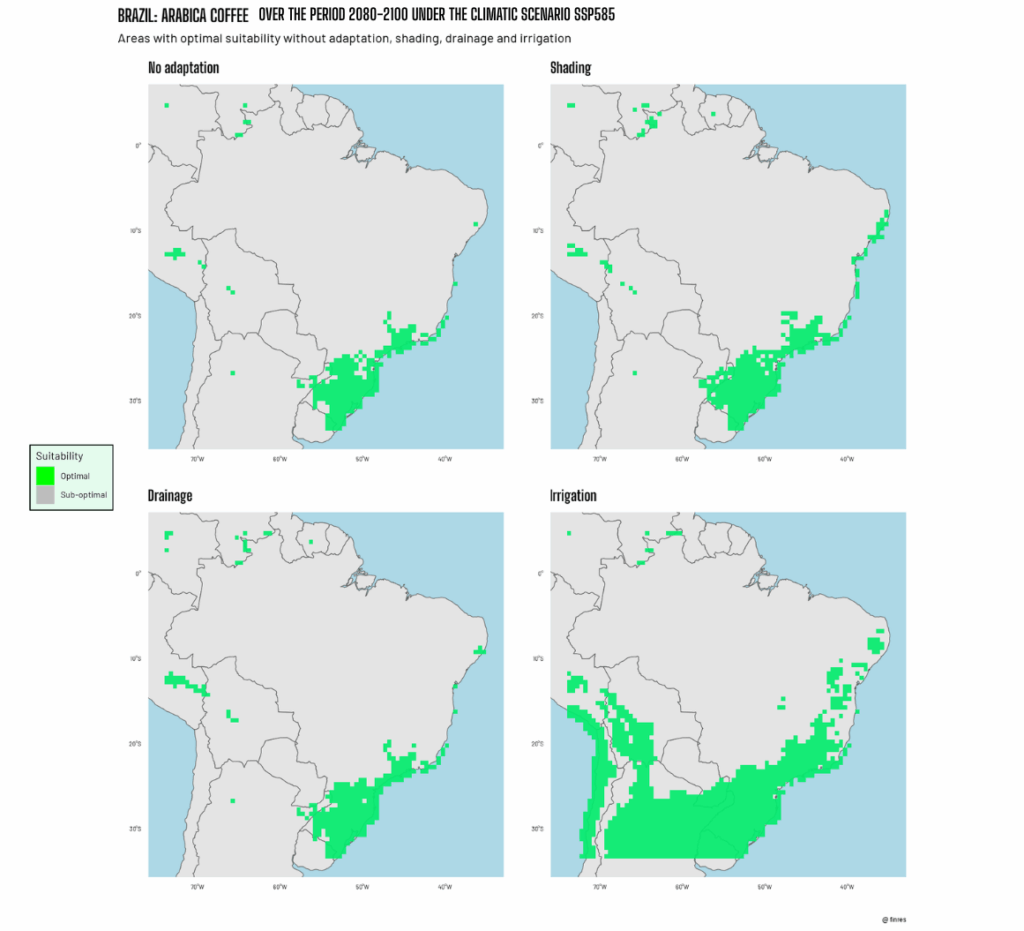Why this matters
The shift in crop suitability: a threat to global food security
These shifts go beyond the agricultural sector and farmer communities: they threaten global food security, food sovereignty, trade, and economic stability. An increasing number of countries will have to rely on imports of food products to feed their populations, placing them at risk of price spikes and disruptions in global food supply chains.
This study was initiated to address identified gaps in existing assessment models and provide a more robust evaluation of crop suitability changes. It was commissioned by the International Fund for Agricultural Development (IFAD, the UN fund specialized in agriculture) and, the French Development Agency, in partnership with the Food and Agriculture Organization of the United Nations (FAO).
Methodological framework
Our methodology to assess climate impacts on crop suitability
The new methodology introduces key refinements over existing approaches and models.
1. Comprehensive water balance calculation
Conventional models often analyze temperatures and precipitation suitability in isolation. Our new methodology relies on the Climatic Water Balance (CWB), the long-term difference between precipitation and evapotranspiration.
- CWB accounts for both water deficit (drought risk – induced by low precipitation and / or excess evapotranspiration, and water excess (flooding risk) – associated with rainfall above a crop-specific threshold.
- CWB is then also constrained by a temperatures suitability assessment to account for temperatures outside the tolerance range of a given crop.
- This combination of temperatures and precipitation in the water balance suitability provides a more realistic assessment of how climate variability and change affect agricultural yields – and with evapotranspiration embedded, this approach is also better equipped to account for climate changes.
2. Focus on optimal yield conditions
Process for finding the optimal climatic water balance:
- Identify global areas where crops reach their highest yields
- Pinpoint ‘optimal suitability’ zones and track their decline.
- Identify new areas where optimal conditions could be reached
3. Built on a foundation of rigorous data
- Climate projections: the assessment relies on an ensemble of five climate models (GCMs) from the ISIMIP database, run under the SSP2-4.5 and SSP5-8.5 scenarios.
- Crop selection: the peer-reviewed paper focuses on nine globally vital crops: Arabica coffee, cassava, common beans, common wheat, maize, plantain, rice, sorghum, and sugarcane, which collectively represent over 50% of the global caloric intake. The data made available online in the FAO database covers 36 crops in total.
- Timeframes: suitability was assessed across four 20-year periods: Past (1995-2014), Present Day (2015-2034), Medium Term (2040-2059), and Long Term (2080-2099).
- Spatial resolution: the analysis was conducted globally at a spatial resolution of approximately 0.13 x 0.13 degrees (approx. 30km at the Equator).
Key findings
5 out of 9 major crops are seeing their optimal growing areas already shrinking.
Our research reveals a critical ‘peak suitability’ for many vital crops, exposing millions to food insecurity, price hikes, and trade disruptions, especially in developing nations.
Key crops could see their optimal suitable land halved by 2100.
For coffee, cassava, beans, wheat, plantain, the global area with optimal growing conditions has already peaked and is now on a downward trajectory. Some could see optimal suitable land halved by 2100. For all these crops, farmers, the agricultural sector, national economies and (international) supply chains must anticipate a decline in yields and act now to adapt rapidly.
Tropical and subtropical regions are particularly vulnerable.
For instance, major coffee-producing regions such as Brazil, Vietnam, and Indonesia are projected to experience substantial further declines in land suitability for Arabica coffee over the next decades, to only half or less by 2100. The same applies to tea in for example in India.
A temporary short term reprieve for maize & rice.
While maize and rice may experience initial gains in the expansion of suitable areas in the near to medium term, this trend is projected to reverse by the late 21st century, particularly under higher-emission scenarios. For maize, the eventual decrease is as large as the initial increase, if future warming remains modest. However, the decrease is much more severe under stronger future warming, leading to a much smaller global land area suitable for this crop that is currently much smaller than it is today.
Key findings
Demonstrated efficacy of adaptation strategies to mitigate losses
Our study identified significant risks for many key crops. This calls for immediate action, which is why we also evaluated the potential of several agricultural adaptation strategies to mitigate projected climate-driven suitability losses.
Irrigation
Potentially increasing the extent of optimal suitable land from 5-25% to nearly 50% for crops such as maize, beans, coffee, and rice. Assuming that water is available, technically and ecologically extractable, irrigation could open significant new areas to farming, especially in desert areas.
Drainage
For maize and sorghum in regions susceptible to water excess, effective drainage systems could improve land suitability by a factor of five. In mid to high northern and southern latitudes (poleward of 45°), drainage becomes more and more relevant as precipitation shifts towards increased winter precipitation.
Shading
Shading practices, such as those used in agroforestry systems, demonstrated potential to increase coffee suitability by up to 20% in areas experiencing temperature increases beyond optimal thresholds.
The need for investment
While implementing such measures involves investment, doing nothing may be far costlier. Our research demonstrates that targeted adaptation strategies can yield significant returns in terms of maintaining (or even enhanced) agricultural productivity and resilience.
Even just adapting to current climate, the technologies tested already bring positive returns to farmers, governments, and investors by improving crop growing conditions right now.
Interested in collaborating on future research in agricultural climate adaptation?
Our team would love to hear from you.





